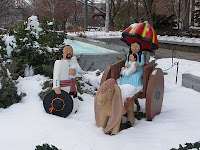Day 2 we headed over to Canyons Ski Resort. We had a lot of fun on most of the slopes, but Anna took a nasty spill on Doc's Run - a blue slope but with a couple of pretty challenging sections especially with the thin snow cover (they only had about 23" base). The Canyon's is huge with a lot of runs, though most of the runs cater to more experienced skiers. I did not like the fact that you needed to take a Gondola ride to get to the main ski area - if you have non-skiers in the group, they'll miss out on most of the action, and the place is so huge that it is hard to get the family back together.
Day 3 was Solitude Ski Resort. We had planned on going to Brighton, but the parking lot was full and they were turning everyone away. So us (and a lot of other cars) headed to Solitude. Great setup for day skiing. Nice lift service on the Moonbeam Express right from the lodge and a wonderfully easy beginners slope. The main ski area at top of Moonbeam is massively open - just going from one side to another is a decent run. The green slopes I thought were borderline blue, but the blue slopes are fantastic, wide, with steep areas and rollouts. This is a great place for intermediate skiers. True beginner skiers are confined to one lift that had very long lines all day long (Link duo). If you ski this, ski right from Moonbeam list to the Apex lift and stay on Apex and Sunrise lifts - no lines and great runs. As a plus the drive up and down the canyon is quite scenic.
Day 4 we took the ski bus to Brighton. It may be the holidays - but the bus was packed ($3.50 per person each way) going both up and back from the resort. The bus has convenient pickups to go up Big Cottonwood Canyon from the base. I enrolled Anna is ski school (the locals recommended it highly). I headed up the main lift (Majestic) and was rewarded with incredible blue and green runs, a terrain park, lots of cuts, carves, trees to ski through - and generally great skiing. The green slopes were nice and easy, the blue slopes were relatively easy blue with nice open areas to bail across the slope of you lost control. The half-pipe and terrain park are below the lift line - so you get entertainment on the way up the lift. Anna progressed wonderfully in ski school. Here is some of the Green terrain in the video.
Day 5 - Since Catherine was still not feeling like skiing and Anna was tired - we decided to hit Park City Resort. This is the best place to go if you have skiers and non-skiers as there is a lot to do there besides ski. The girls went ice skating while I decided to see if I could do every lift on the mountain in just half a day. I finally decided to bail on my quest - though I was only 3 lifts shy (Eagle and First Time which go from the base were 2 that I missed). I hit Payday blue run over and over and really enjoyed the view and the run as it had a high speed lift and it was a challenging enough blue to give me a real workout.
I left the slopes tired and feeling pretty good. Park City is really the premiere resort (expensive though). The number of runs and quality of all the runs is very good. My recommendation is that if you have a mix of skiers and non-skiers, go here and let the non-skiers explore all the other things in the resort and in Park City while you ski your heart out.
Day 6 - The plan for today was to hit Brighton again and the snow ski school. Anna was switching to board to take classes with Catherine. We headed out around 10:30 and quickly realized from the traffic that every resort was going to be packed (Alta, Snowbird, Solitude, and Brighton). A mile outside of Brighton that traffic came to a complete stop and we realized we were not going to be able to ski at the resorts. We turned around and found a really cool camping area and sledding hill along the mountain (with plenty of others). We hiked and did "poor man skiing" basically walking up the hill and boarding/skiing down.
After the playing in the Wasatch woods we headed downtown. One of the highlights was Temple Square. There were (besides other things) Nativity scenes from different countries.

Day 7- Back to Brighton - We finally made it up to Brighton for a final full day of skiing. I put everyone (including myself) in lessons. My instructor - Brian was awesome. I was able to correct my posture, cure putting my arms behind my body, and improve my hip motion. Black runs that I used to find intimidating became fun. I found myself seeking steeper terrain. Linda, Catherine, and Anna also all enjoyed their runs. Also the views from the top of the mountains in Brighton are incredible.
Day 8 - We drove up Little Cottonwood Canyon to see Alta Ski Resort and Snowbird. As always a beautiful drive and hopefully we'll get a chance to ski them on the next trip. After that it was to the Museum of Natural History at University of Utah where we got to see scientists and technicians working on excavations of a new uncategorized dinosaur ( a cool looking Triceratops looking dinosaur) and tour the museum - which is a pretty awesome museum.






























